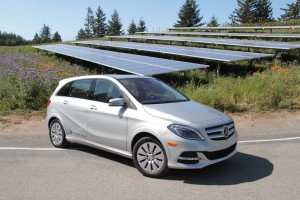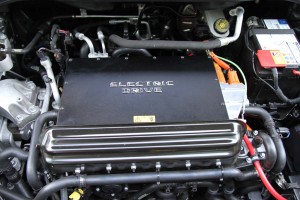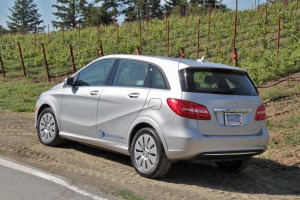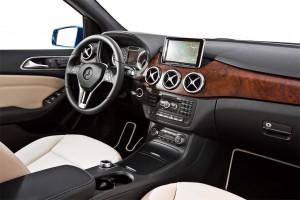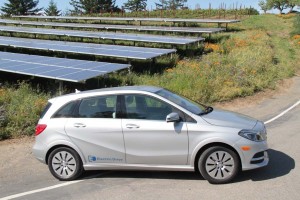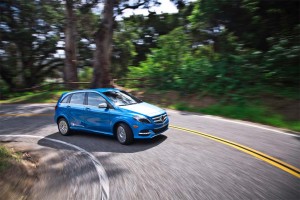With the debut of the new B-Class Electric Drive, Mercedes-Benz not only becomes the latest entrant into the fast-growing battery-car line-up, but also sets out to prove that everything you thought you knew about electric vehicles is wrong. Well, almost everything.
The battery-powered version of the maker’s European compact hatchback is certainly no stripped-down econobox. And you’re delivered a pleasant, neck-snapping surprise when you stomp on the throttle. As for the price tag, while significantly more than a Nissan Leaf or Ford Focus Electric, the Mercedes model is nonetheless reasonably affordable once federal and state incentives are calculated in.
There is that little issue of range, however, that continues to plague the B-Class Electric and just about every other entry into the battery-car segment with the exception of the Tesla Model S. Ironically, Mercedes can thank that upstart start-up for some of the B-Class Electric’s most appealing attributes.
Skeptics will undoubtedly deride the Mercedes-Benz B-Class Electric Drive as just one more “compliance car,” a vehicle that has been cynically foisted on the California market in order to meet the Golden State’s tough zero-emissions vehicle, or ZEV standard. There’s undoubtedly some truth to that. Like all of its major competitors, Mercedes must deliver a minimum number of clean vehicles or face the unsettling prospect of being blocked from selling cars in one of the world’s single-largest luxury vehicle markets.
But the maker insists it is serious about electric propulsion – and a variety of other alternatives, ranging from CNG to hydrogen fuel-cell vehicles. In 2015, it plans to expand from California and a handful of other ZEV mandate states to cover the entire U.S. with the B-Class Electric. And company officials promise they have other offerings in the works, notably in partnership with Tesla which developed the battery drivetrain for the original Smart Fortwo Electric Drive, and now the B-Class Electric.
(Start-up Terrafugia developing a flying plug-in hybrid. Click Here to check it out.)
In the Mercedes model, that translates into a single-motor system that produces 177 horsepower and a very sporty 251 pound-feet of torque. No, you won’t win a race with a CLA 45 AMG – which shares the same underlying platform – but at 0 to 60 in just 7.9 seconds, the B-Class Electric belies the image of the stone cold slow EV.
(Indeed, Tesla’s hand is also obvious in the unexpectedly peppy performance of the Toyota RAV4-EV, for which it also provides the battery drivetrain.)
The B-Class Electric draws its power from the requisite lithium-ion battery, here a 28 kilowatt-hour pack housed under the vehicle’s load floor. That offers another advantage, lowering the center of gravity of the vehicle enough that you generally don’t notice the extra 500 pounds added to the roughly 3,900 pounds of a comparable, gas-powered Mercedes-Benz B-Class.
(Over half of all new vehicles now deliver at least 23 mpg. Click Here for more.)
The B-Class proved more nimble than we expected while driving along Skyline Drive in the Santa Cruz Mountains framing Silicon Valley. The added battery mass, however, did translate into a bit more jounce on rough pavement.
While the Tesla collaboration pays off in the Electric’s more electrifying performance, the B-Class doesn’t share the oversize battery pack options available for the Tesla Model S – up to nearly 300 miles with the 85 kWh pack. As a result, Mercedes planners anticipate their battery hatchback will be given an official EPA rating of only around 85 miles by the time the new model reaches U.S. showrooms mid-year.
That’s a bit less than its European rating but is probably closer to what motorists would get here in real world driving. A couple days of jaunting around the Silicon Valley region suggests that 85 miles would likely be the norm under routine driving, with a few aggressive starts and some attention to maximizing regen when possible – ensuring you recapture as much energy as possible when braking or coasting.
One nice feature added to the B-Class Electric is the ability to “overcharge,” or boost the amount of power it can store, increasing range by about 10%. Why not simply make that the norm? The concern is that this would reduce battery life. That said, overcharging repeatedly will not void the B-Class Electric’s battery warranty which extends for 8 years and unlimited mileage. The protection kicks in if the pack’s capacity drops below 70% of its original rating.
Charging times, incidentally, are rated at just 3.5 hours using a suitable Level II 240-volt system. You don’t want to think about plugging into a standard 120-volt outlet unless you’re staying home for the weekend.
Disappointingly, Mercedes did not equip the B-Class with a 480-volt DC Level III charging system which could give it an 80% top-off in around 20 minutes or so. For now, there are few of these chargers available in the U.S. but they’re expected to multiply rapidly over the coming years. Company officials suggest they will add a Level III function to the updated battery-car in a few years.
We briefly mentioned regen, or regeneration, a moment ago, but it deserves a bit more of an explanation. This is what conventional hybrids rely on, recapturing kinetic energy and reusing it to reduce dependence on their gas engines. In a battery-electric vehicle, regen can add significant range. And Mercedes has come up with a creative way to allow a driver to maximize the amount of energy the vehicle recaptures.
What, at first, looks like a pair of paddle shifters actually allows a motorist to change the way the B-Class Electric behaves, most notably by increasing the rate of regeneration. In its most aggressive setting, you’ll feel like you’ve down-shifted several gears in a conventional gas-powered vehicle, here maximizing the amount of kinetic energy that goes back to the battery.
At the other extreme, the B-Class Electric also boasts a Sport setting that provides a notable boost to its acceleration – albeit while also sucking power out of the battery with a much larger straw.
If the name, B-Class doesn’t ring a bell, that’s no surprise. Though the nameplate has been around for a few years it has not, until now, been offered in the U.S. market. Mercedes didn’t think there’d be enough demand here for something that small – though the strong sales of the similarly sized new CLA might suggest otherwise. For now, American dealers will only be offering the B-Class with battery drive.
(Tesla gains new allies in fight to sell cars directly to consumers. Click Here for the latest.)
The oversized tri-star badge on the grille attracts immediate attention, though the basic appearance is that of an attractive, if relatively generic compact hatch. The coupe-like roof doesn’t demand much interior compromises, even in the back seat. And the tall seating layout ensures both good leg room for up to five passengers, and a fair bit of cargo space.
The seats are classic Mercedes and proved both comfortable and supportive after several hours of driving. The interior isn’t up to the lavish levels of the latest C-Class remake but is at least as appealingly finished as the new CLA coupe-like sedan. The basic controls – with the exception of the paddle-shifter functions – are classic Mercedes, including the COMAND-based infotainment system.
One suggestion for the automaker would be to make it easier to find the infotainment screen that provides information on the way that the electric drivetrain is operating. That takes a bit of digging which is odd considering most competitors like to have that information readily apparent to anyone driving their hybrids, plug-ins or battery-electric models.
As with a growing number of competitors, Mercedes-Benz B-Class Electric Drive buyers will be able to access information about the vehicle, such as state-of-charge, through a remote smartphone app, and even control functions such as pre-heating the vehicle while still connected to the charger on a cold morning.
The navigation system will come as standard on the B-Class Electric, along with a fairly expansive range of other features, including satellite radio. The car also gets a modified version of the Mercedes Collision Prevention system which will actually increase regen should the car ahead slow down – effectively braking a bit for you. But unlike the system offered on conventional Mercedes models, it won’t bring the B-Class Electric to a complete stop to avoid a crash. There’s also blind-spot monitoring, lane-keeping assist and parking assist on the options list.
(Tesla owners in San Francisco receive some strange warnings. Click Here to find out more.)
In all, there’s a lot for your $41,450 – plus $925 destination charge. And it’s even more impressive when you add in the $7,500 federal tax credits and another $2,500 in California state credits a buyer could qualify for. After working in those discounts you’re talking only slightly more than for the new Mercedes CLA, which starts at just under $30,000.
Battery-cars still make up a miniscule part of the overall U.S. market, barely 1%, though sales growth has significantly outpaced that of the overall market during the last several years. Mercedes hopes to pick up on that momentum as it rolls out the new B-Class Electric Drive. And if our first experience with the alternative hatchback is any indication, it should do quite well.
The new Mercedes B-Class is one of the rare electrics that falls into the fun-to-drive category. It’s also got a functional advantage over many of its competitors and, of course, the tri-star logo is a definite draw. Its range will undoubtedly limit its appeal – even among those who might be able to get by with 85 miles per charge. Range anxiety is just a difficult thing to overcome. But for those who are looking for an affordable battery-car option, the new Mercedes-Benz B-Class Electric Drive should definitely be on the list.

